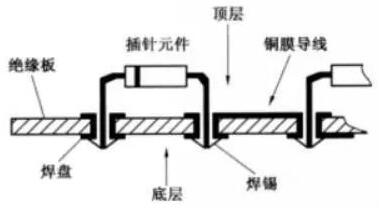The printed circuit board (PCB) is used to carry electronic components and provide a mother board for circuit connection of various components. From the structural point of view, PCB is divided into single-sided, double-sided and multi-layer boards.
Single panel
Single-sided board is on the most basic PCB, the parts are concentrated on one side, and the wires are concentrated on the other side. Because the wires only appear on one side, we call this kind of PCB a single-sided (Single-sided). Because single-sided boards have many strict restrictions on the design of the circuit (because there is only one side, the wiring cannot cross and must be around a separate path), so only early circuits use this type of board.
Single-panel wiring diagrams are mainly screen printing, that is, a resist is printed on the copper surface, and after etching, the mark is printed with a solder mask, and finally the part guide hole and the part are completed by punching. shape. In addition, some products that are produced in small quantities and diversified use photoresist to form patterns.
Double panel
The double-sided board is a printed circuit board with copper coated on both sides including Top (top) and Bottom (bottom). Both sides can be wired and soldered. There is an insulating layer in the middle, which is a commonly used printed circuit board. Both sides can be wired, which greatly reduces the difficulty of wiring, so it is widely used.
There are wiring on both sides of the double-sided board, but if you want to use the wires on both sides, you must have a proper circuit connection between the two sides, as shown in the figure:

The "bridges" between such circuits are called vias. A via is a small hole filled or coated with metal on the PCB board, which can be connected with the wires on both sides. Because the area of the double-sided board is twice as large as that of the single-sided board, the double-sided board solves the difficulty of interleaving wiring in the single-sided board (it can be conducted to the other side through the hole), and it is more suitable for more complicated circuits than the single-sided board.
Multilayer board
PCB multi-layer boards refer to multi-layer circuit boards used in electrical products. Multi-layer boards use more single-sided or double-sided wiring boards. Use one double-sided as the inner layer, two single-sided as the outer layer, or two double-sided as the inner layer and two single-sided as the outer layer of the printed circuit board. The positioning system and the insulating bonding material alternately together and the conductive pattern Printed circuit boards that are interconnected according to design requirements become four-layer and six-layer printed circuit boards, also known as multilayer printed circuit boards. Common multi-layer boards are generally 4-layer boards or 6-layer boards, and complex multi-layer boards can reach dozens of layers.
Features:
The biggest difference between PCB multi-layer boards and single-sided and double-sided boards is the addition of an internal power layer (to maintain the internal electrical layer) and a ground layer. The power supply and ground wire networks are mainly routed on the power layer. However, multi-layer board wiring is mainly based on the top and bottom layers, supplemented by the middle wiring layer. Therefore, the design of the multi-layer board is basically the same as the design method of the double-sided board. The key is how to optimize the wiring of the inner electrical layer, so that the wiring of the circuit board is more reasonable and the electromagnetic compatibility is better.
The difference between double-sided board and multi-layer board
In terms of process, the difference between double-sided board and multi-layer board:
1. The pressing material of the double-sided board is only P sheet and Cu foil; the pressing material of the multilayer board includes both the P sheet and the two outermost Cu foils, as well as the inner layer between the P sheets.
2. The production of multi-layer boards is more than the production of inner-layer boards. The manufacturing of the inner layer board is similar to that of the outer layer board.